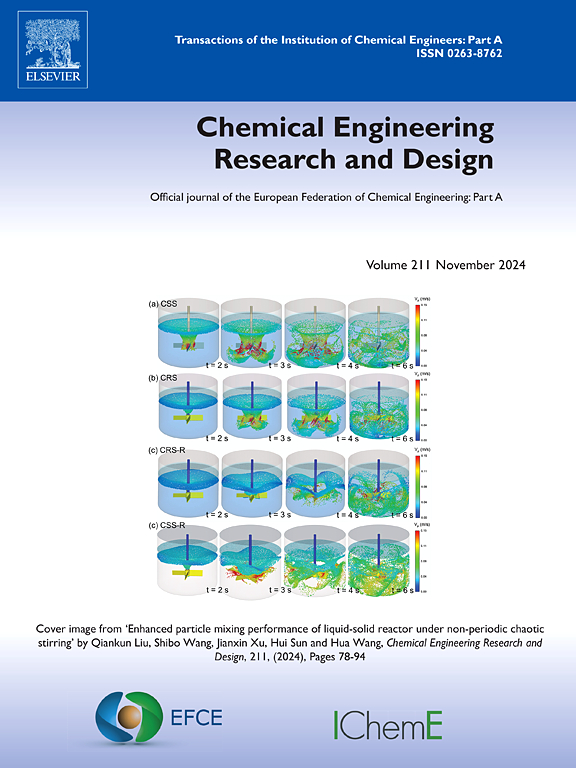七氟丁醇醋酸酯:七氟丁醇与醋酸异丙酯在酸性催化剂存在下反应-化学、相行为、间歇反应精馏过程
IF 3.7
3区 工程技术
Q2 ENGINEERING, CHEMICAL
引用次数: 0
摘要
本文研究了2,2,3,3,4,4,4-七氟丁醇(HFBol)与醋酸异丙酯(IPAc)在酸性催化剂存在下,在混合反应器和间歇反应精馏(BRD)过程中的反应。通过核磁共振和气相色谱-质谱法鉴定,反应产物包括2,2,3,3,4,4,4-七氟乙酸丁酯(HFBAc)、异丙醇(IPol)、乙酸(AAc)、水、二异丙基醚(IPEth)和七氟丁基异丙基醚(hbf -IPEth)。该体系发生以下反应:HFBol和IPAc的酯交换反应生成HFBAc和IPol;IPol和HFBol的分子间脱水形成IPEth和HFB-IPEth,而AAc和IPol是通过IPAc的水化形成的。此外,AAc与HFBol同时发生酯化反应,生成HFBAc和水。该研究还考察了温度、压力、初始反应物比和催化剂浓度对反应动力学的影响,以及BRD过程的动力学方面。建立了转化率和选择性值与工艺参数之间的关系。本文主要介绍了氟化酯技术,同时也介绍了IPol的化学性质及其相关工艺。本文章由计算机程序翻译,如有差异,请以英文原文为准。
Heptafluorobutyl acetate: Heptafluorobutanol and isopropyl acetate reaction in the presence of an acidic catalyst – chemistry, phase behavior, batch reactive distillation process
This work studies the reaction between 2,2,3,3,4,4,4-heptafluorobutan-1-ol (HFBol) and isopropyl acetate (IPAc) in the presence of an acidic catalyst in a mixing reactor and during the batch reactive distillation (BRD) process. The reaction products, identified using NMR and gas chromatography–mass spectrometry, include 2,2,3,3,4,4,4-heptafluorobutyl acetate (HFBAc), isopropanol (IPol), acetic acid (AAc), water, diisopropyl ether (IPEth), and heptafluorobutyl isopropyl ether (HFB-IPEth). The system undergoes the following reactions: the transesterification of HFBol and IPAc produces HFBAc and IPol; intermolecular dehydration of IPol and HFBol results in IPEth and HFB-IPEth, while AAc and IPol are formed through the hydration of IPAc. Additionally, the esterification reaction between AAc and HFBol occurs simultaneously, forming HFBAc and water. The study also examines the effects of temperature, pressure, initial reactant ratios, and catalyst concentration on the reaction kinetics, as well as the dynamic aspects of the BRD process. Relationships between conversion and selectivity values and process parameters are established. This article primarily focuses on fluorinated ester technology while also addressing the chemistry of IPol and related processes.
求助全文
通过发布文献求助,成功后即可免费获取论文全文。
去求助
来源期刊

Chemical Engineering Research & Design
工程技术-工程:化工
CiteScore
6.10
自引率
7.70%
发文量
623
审稿时长
42 days
期刊介绍:
ChERD aims to be the principal international journal for publication of high quality, original papers in chemical engineering.
Papers showing how research results can be used in chemical engineering design, and accounts of experimental or theoretical research work bringing new perspectives to established principles, highlighting unsolved problems or indicating directions for future research, are particularly welcome. Contributions that deal with new developments in plant or processes and that can be given quantitative expression are encouraged. The journal is especially interested in papers that extend the boundaries of traditional chemical engineering.
 求助内容:
求助内容: 应助结果提醒方式:
应助结果提醒方式:


